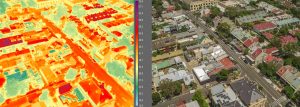
Photo: Mark Metcalfe/City of Sydney
Sydney to cover 40 percent of the city in greenery to beat heat
26 March 2021
by Sarah Wray
The City of Sydney plans to plant 700 new street trees a year and dramatically increase green roofs and walls to mitigate rising heat. The ultimate aim is to cover 40 percent of the city’s footprint with greenery by 2050.
If passed, the Greening Sydney 2030 strategy will update and supersede Sydney’s first greening plan which was launched in 2012.
“We’re in the middle of a climate crisis and we are already experiencing its impacts,” said Lord Mayor Clover Moore. “Dangerous heatwaves are arriving earlier, are hotter and last longer. Our city must adapt to the changing climate and increase its resilience to the likely impacts.”
“Trees and other urban greenery are as essential as roads and broadband internet. Effective and extensive canopy cover can reduce temperatures on the ground by up to 10 degrees,” she added.
Extreme heat already kills more people in Australia than any other natural disaster, including floods, cyclones and bushfires. In January 2020, during a devastating bushfire season, Sydney was struck by a heatwave that broke temperature records, reaching 48.9C in the suburb of Penrith.
Targets
A budget of AUS$377 million (US$287 million) has been proposed for greening in Sydney over the next ten years. Targets include 23 percent canopy cover by 2030, rising to 27 percent by 2050, up from 19.2 percent in 2020 and 15.5 per cent in 2008.
Under the plans, public and private buildings would provide 28 percent of green cover, including 20 percent tree cover.
A data-driven approach will be used to guide equitable coverage and prioritise areas.

Green Factor Score
The city will gradually amend planning controls to increase the adoption of green roofs in new developments and retrofits on existing buildings. This will include the use of a Green Factor Score to evaluate and quantify the amount and quality of urban greening a project provides.
Sydney’s 38.3 hectares of narrow streets, or ‘laneways’, are also a priority.
A new Greening Sydney Fund is being created. If council-owned trees have to be removed as a last resort, compensation would go into the fund, which could provide matching grants for residents and landowners to undertake greening projects.
The city said it will continue to encourage community participation in adding more greenery to the city, including supporting education programmes and citizen science initiatives as well as championing community gardens, footpath gardening projects and other efforts.
Health benefits
As well as mitigating heat, adding green infrastructure can offer wider benefits.
Sydney’s strategy was developed in line with research conducted by University of Wollongong Professor Thomas Astell-Burt.
“Residents tend to be happier, healthier and more social when there’s more green space in the community, with potentially large economic benefits too”, Professor Astell-Burt said.
“The case for greening goes well beyond aesthetics. With our work in Australia, and others around the world reporting reduced risks of diabetes, dementia, and distress, this means street trees, gardens, parks and other natural settings are a key part of a city’s essential public health infrastructure.”
Astell-Burt cited a recent study which found that 56 percent of Sydney residents felt ‘solace and respite’ in green spaces during the Covid-19 pandemic last year, while 34 percent indicated they visit green spaces for exercise more now than before the pandemic.
“We know people tend to socialise, dine and linger longer in green environments, which means there are benefits to a city’s economy from these transformations,” he said.
If endorsed by the council this month, the draft strategy is set to be put out for public consultation during April and May, with an aim to have it approved around July.







